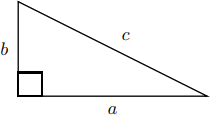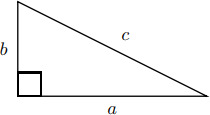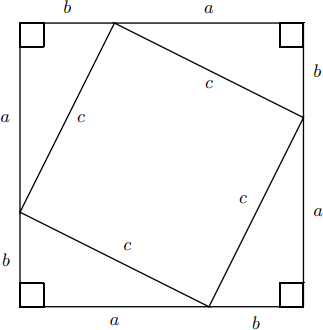2.4: El teorema de Pitágoras
- Page ID
- 108429
El Teorema de Pitágoras relaciona las longitudes de las patas de un triángulo rectángulo y la hipotenusa.
Teorema\(\PageIndex{1}\): The Pythagorean Theorem
Si\(a\) y\(b\) son las longitudes de las patas del triángulo rectángulo y\(c\) es la longitud de la hipotenusa (el lado opuesto al ángulo recto) como se ve en esta figura.

entonces
\[a^{2}+b^{2}=c^{2}\nonumber\]
Prueba
Se puede verificar la verdad del Teorema de Pitágoras midiendo diversos triángulos y comprobando para ver que satisfacen\(a^{2}+b^{2}=c^{2}\) dónde\(c\) está la longitud de la hipotenusa y\(a\) y\(b\) son las longitudes de las piernas. No obstante, tendrías que medir cada uno de esos triángulos para conocer su verdad absoluta que, por supuesto, es imposible. Por lo tanto, nos gustaría encontrar una manera de ver que es cierto para todos los triángulos correctos. El Teorema de Pitágoras puede ser visto como cierto considerando la siguiente construcción. Comience con el triángulo (cualquier triángulo rectángulo se puede orientar de esta manera)

luego construya otros tres triángulos que tengan el mismo tamaño y forma que el primero (es decir, congruentes con el primero):

Ahora, compute el área del cuadrado grande de dos maneras:
1. Usando el área de una fórmula cuadrada:
\[\begin{align*} \text {Area} &=(a+b)^{2} \\[4pt] &=a^{2}+2 a b+b^{2} \end{align*}\]
2. Sumando la suma de los cuatro triángulos más el pequeño cuadrado interior:
\[\begin{align*} \text {Area} &=4 \cdot\left(\frac{1}{2} a b\right)+c^{2} \\[4pt] &=2 a b+c^{2} \end{align*}\]
Ya que ambos son iguales al área de la plaza, debemos tener
\[ a^{2}+2 a b+b^{2}=2 a b+c^{2} \nonumber \]
Restar\(2 a b\) de ambos lados da
\[a^{2}+b^{2}=c^{2}\nonumber\]
\(\square\)


